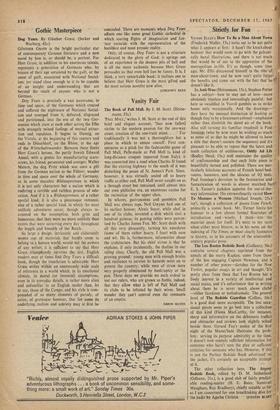,Strictly for Fun
VIViAN ELLIS's How To Be a Man About Town (Frederick Muller, 15s.) turns out to be not quite
what it appears at first: it hasn't the knockabout humour that would seem to go with the galvani- cally banal illustrations, and there is not much that would be of use to the apprentice of the metropolitan in-life. It's as though, some time ago, Mr. Ellis discovered himself in the role of man-about-town, and he now can't quite forgo. the benefits and come out with the fact that he doesn't like it.
In Anti-Woo (Heinemann, 15s.), Stephen Potter has a subject—how to stay out of love—more
obviously timeless and interestingly painful : but
here so swaddled in Yeovil gambits as to strike home only occasionally. And the drawings—
they have the unusual distinction of looking as though they're by a lieutenant-colonel--emphasise rather than diminish the dated air of the book. Also still turning his familiar treadmill is Paul Jennings (who by now must be wishing as much as some of us that he might be allowed to have a title that doesn't sustain the sequence) and it's pleasant to be able to report that the latest and tenth collection of oddlinesses, Oddly Ad Lib (Bodley Head, 15s.) well maintains the quality of craftsmanship and that each little piece is beautifully turned and polished. There are par- ticularly felicitous accounts of French hotel bed- rooms, hamsters, and the idiocies of IQ tests. Paul Jennings's devotion to the fascination and fantastication of words is almost matched bym E. S. Turner's jackdaw appetite for out-of-the- way information. His extraordinarily varied How To Measure a Woman (Michael Joseph, 25s.) isn't, though a collection of pieces from Punch, primarily a comic book. Mr. Turner limits his humour to a few almost formal flourishes of introduction and—wisely, I think—lets the material speak for itself. It's most to my taste when either most bizarre, as in his notes on the indexing of The Times, or most clearly footnotes to history, as in his accounts of the nineteenth- century popular press.
The Leo Rosten Bedside Book (Gollancz, 36s.) contains several chapters reprinted from the annals of the starry Kaplan, some from those of the less engaging Captain Newman, and a number of other pieces—sketches for the New Yorker, popular essays in art and thought.' It's pretty clear from these that Leo Rosten has a lively interest in a variety of intellecthal and social topics, and it's unfortunate that in writing about them he is never much above cliche —either facetious or melodramatic. The general level of The Bedside Guardian (Collins, 16s.) is a good deal more acceptable. The less occa- sional pieces seem to go best into a collection of this kind (Fiona MacCarthy, for instance, sharp and informative on the debutante traffic) and obituaries and reviews look slightly wilted beside them. Gerard Fay's notice of the first night of the Marat/Sade illustrates the prob- lem: serving its purpose admirably at the time, it doesn't now contain sufficient information for someone who hasn't seen the play or sufficient criticism for someone who has. However, if this is not the Perfect Bedside Book advertised on the jacket, it's certainly an acceptable attempt at it.
The other collection here, The Argosy Bedside Book, edited by D. M. Sutherland (Odhams, 21s.), is a good slab of fairly predict- able reading-matter (H. E. Bates, Somerset Maugham, Ray Bradbury), chiefly notable as far as I am concerned for one breathtaking dive for the nadir by Agatha Christie. • QUENTIN sums '






























 Previous page
Previous page